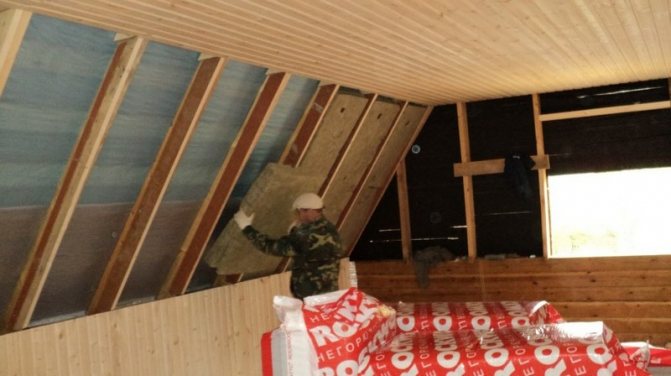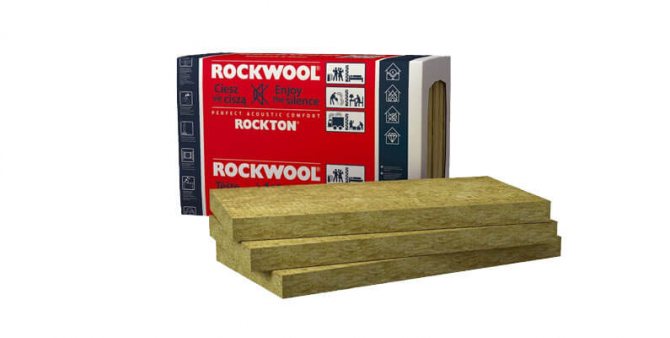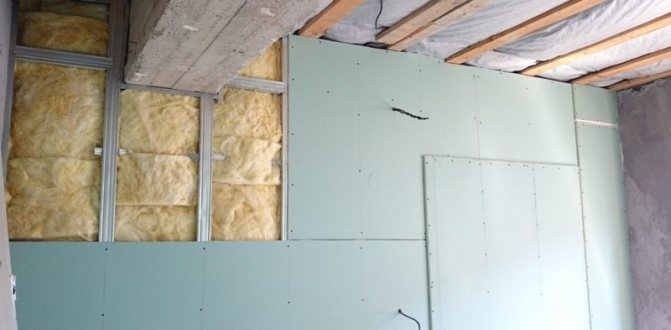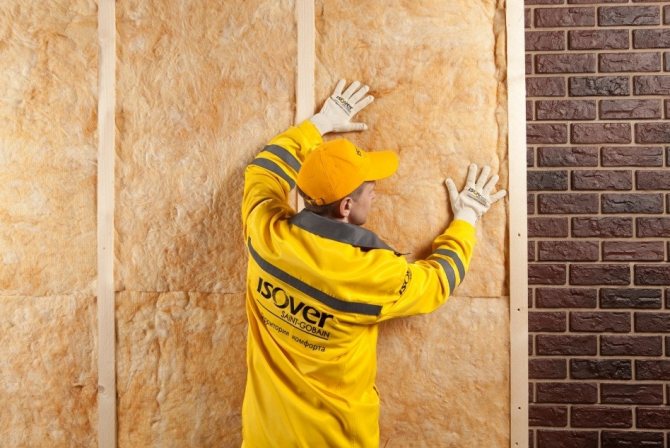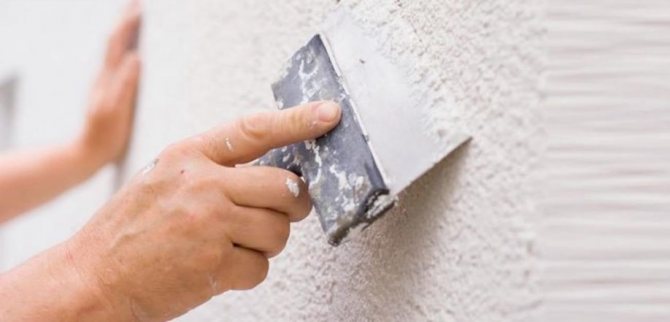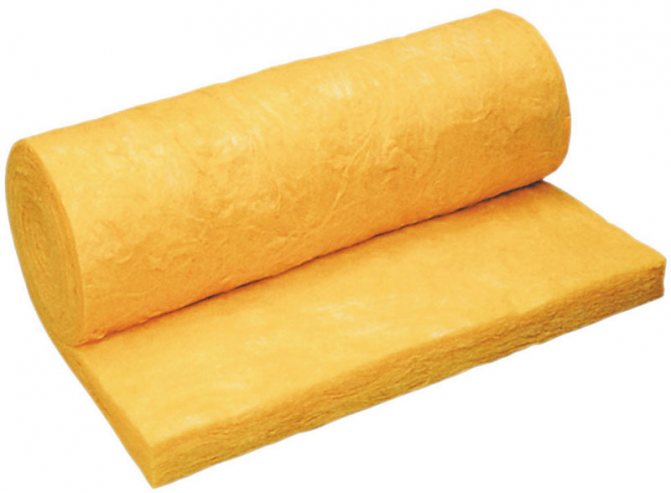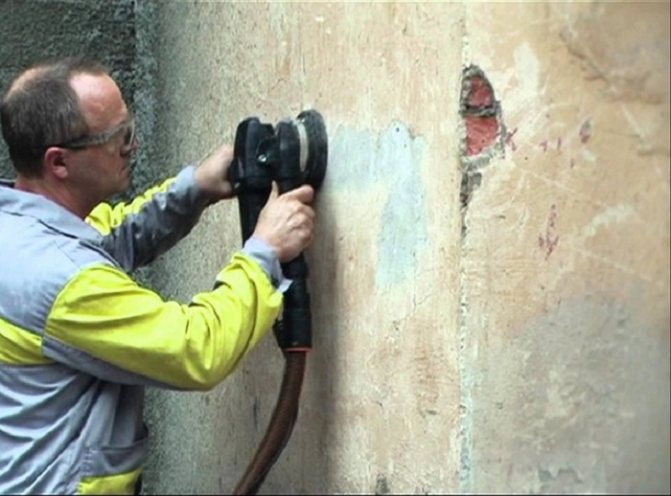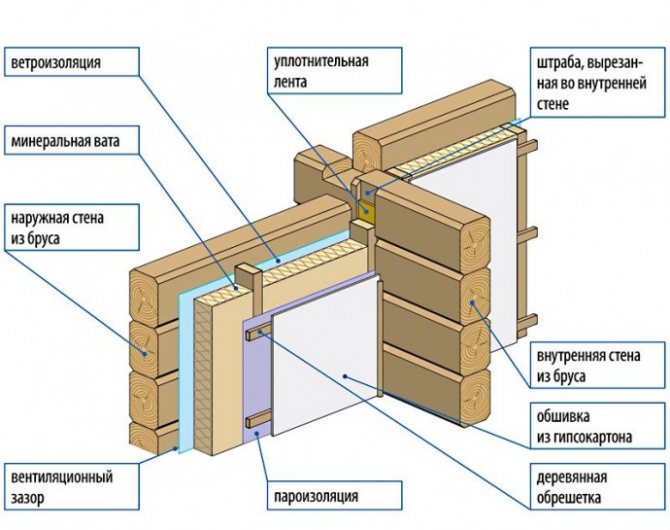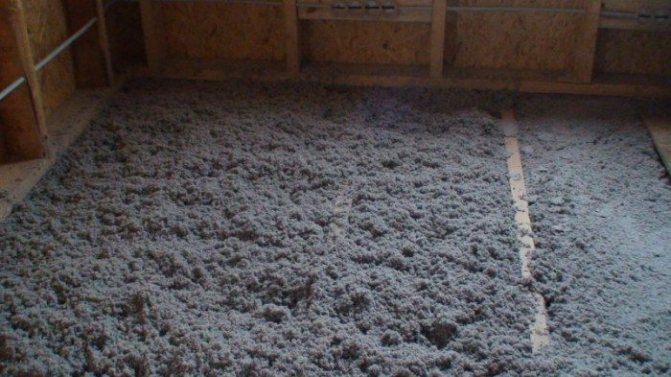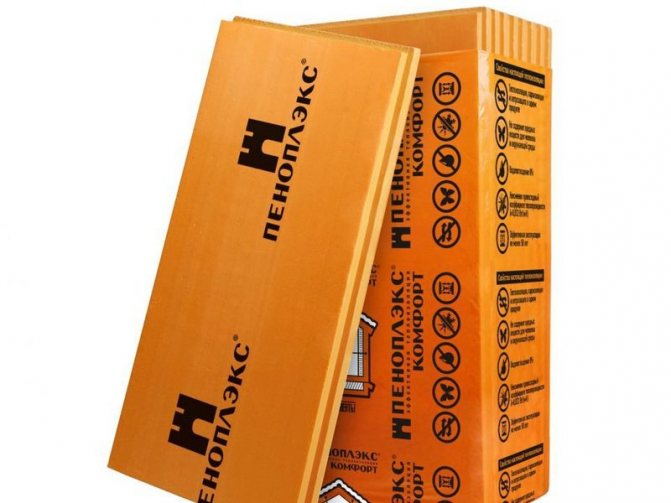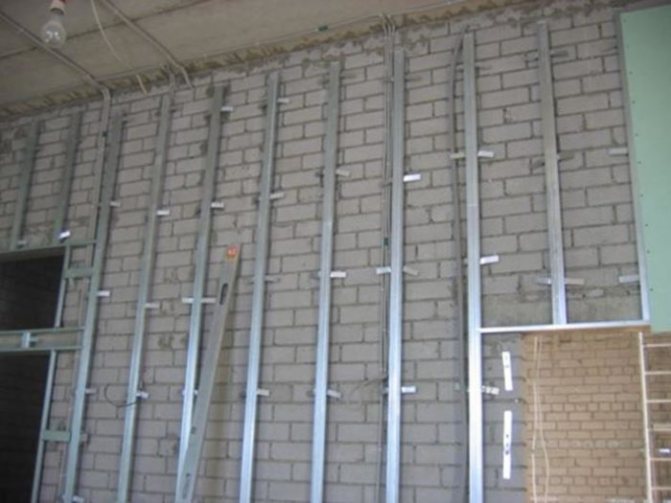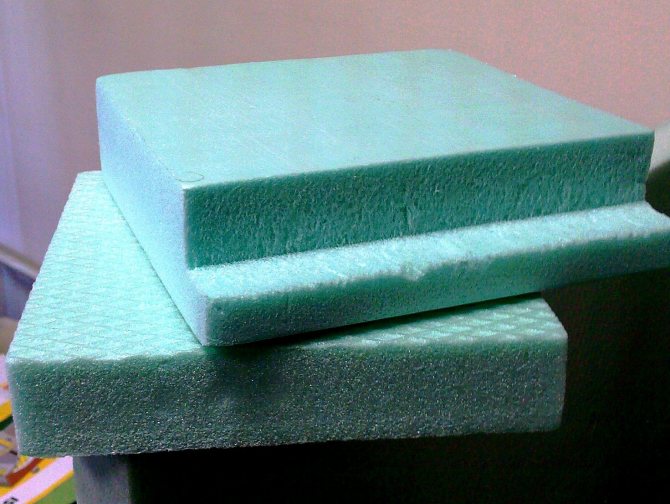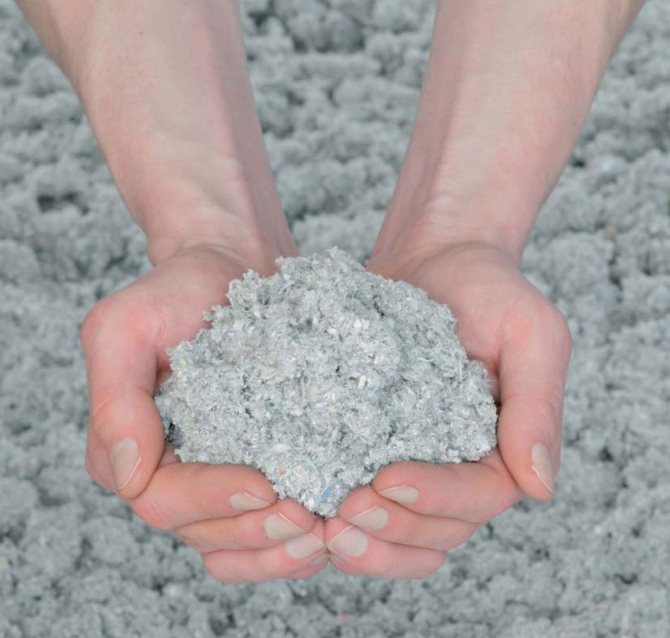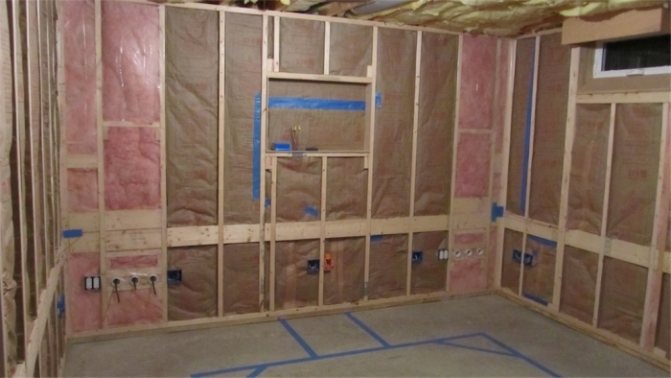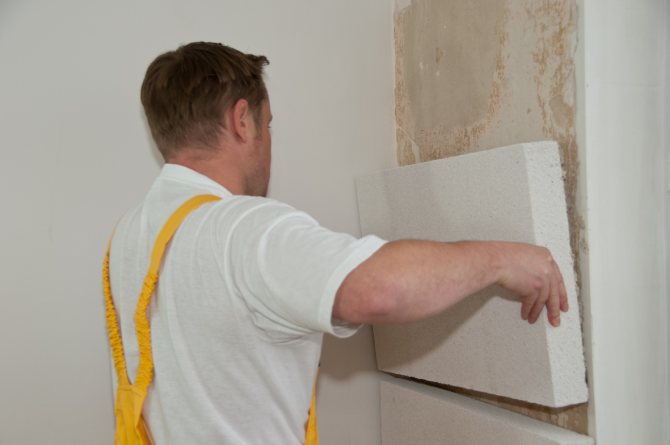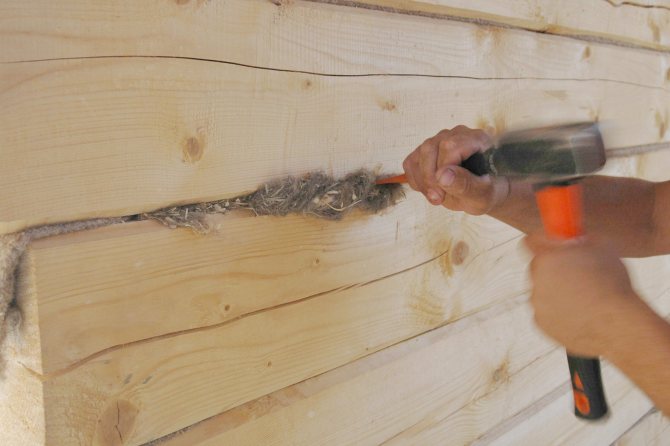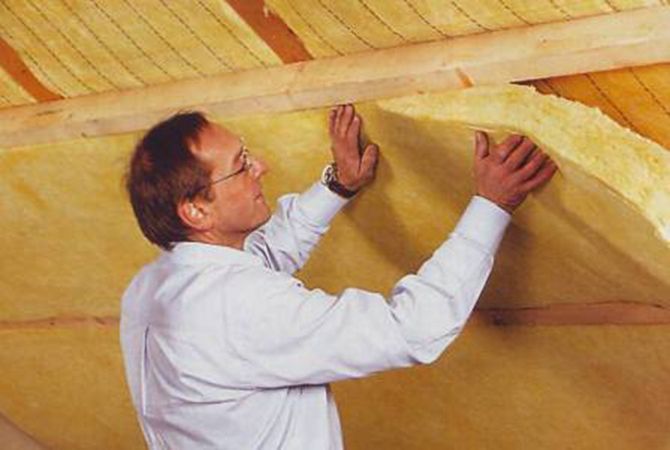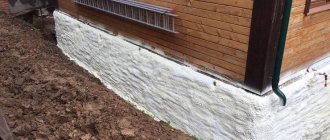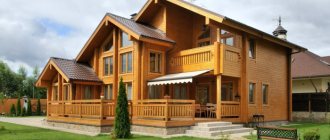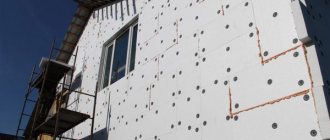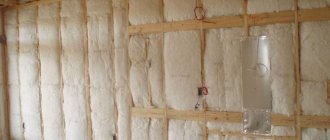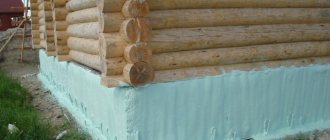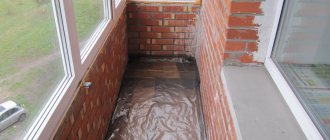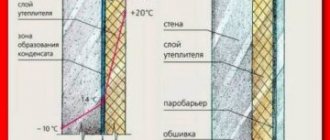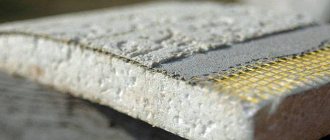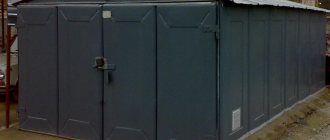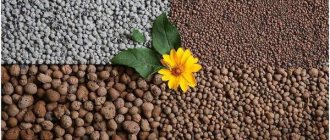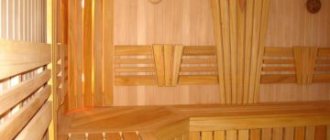Construction science recommends to do external insulation of buildings, since in this case the dew point is located outside the room in the insulation or in the outer layer of the walls. With such insulation, moisture will not condense on the walls in rooms.
But still there are cases when insulation of a wooden house from the inside - is the only correct solution. For example, if the owner of the house wants to preserve the beautiful appearance characteristic of houses made of rounded logs, or the laws prescribe to preserve the historical appearance of the building.
Modern building science allows you to make internal insulation of wooden houses, but for this you should use the right materials and follow the technology.
Why is it necessary to insulate the walls of a wooden house from the inside
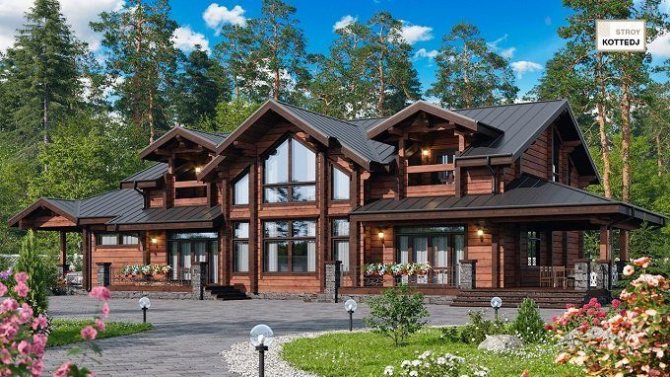
The construction of wooden country houses is only gaining popularity. It's not just the fashion for the Russian wooden style, there are also quite practical reasons for its popularity. For example, a dry wood wall holds heat 2.5 times better than brickwork of similar thickness. Wooden walls also release aromatic substances when they dry out gradually, creating a pleasant atmosphere in the room.
Building regulations regulate the requirements for thermal insulation of buildings. A wood house built in compliance with the required standards is subject to shrinkage for about three years after the completion of construction. Its thermal insulation qualities change over time and do not always comply with the norms, why the house is made of wood and it is required to insulate it from the outside and from the inside.
Wood itself retains heat well. The thermal insulation properties of wood in regions with a warm climate, as a rule, are sufficient to create comfortable living conditions in the house. In areas with harsh winters, the natural qualities of the tree are not enough. This is another reason for insulating a wooden house from the inside.
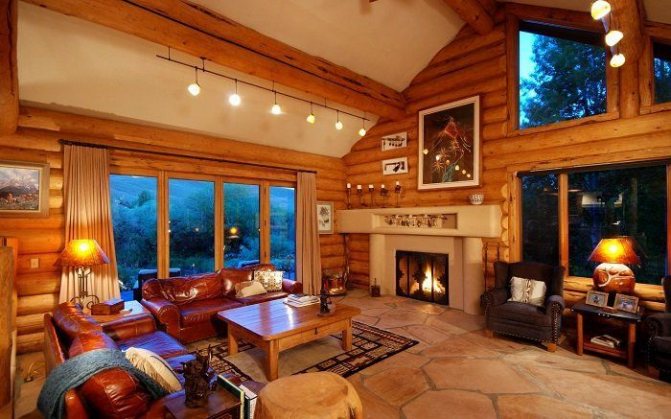

Wooden buildings are most often insulated from the outside due to the fact that the temperature surface of the dew point moves from the side of the wooden wall towards the external insulation. As a result, the thickness of the wall remains dry, protected from rotting and fungal attack, and heats up well.
However, it is not always possible to insulate the house from the outside. For example, the status of an old building as an architectural monument, which prohibits changing its original appearance, may hinder. In this case, it is necessary to insulate the walls of a wooden house from the inside.
Recommended reading:
- Options for houses made of laminated veneer lumber for every taste and budget
- Half-timbered house construction technology
- Types of foundations for a private house
The insulation procedure from the inside is optional, provided that the building is well insulated from the outside. But if it is necessary to preserve the appearance of a wooden house and at the same time make the home warm and comfortable, internal thermal insulation becomes necessary.
When insulating a wooden house from the inside, the walls, floor, ceilings (depending on the number of storeys) and the roof are insulated. Any interior surface that is not covered with thermal insulation material will reduce the overall performance of the insulation. It is more rational to carry out work on thermal insulation from the inside during the construction phase, since it will be much more difficult to insulate an already inhabited interior.
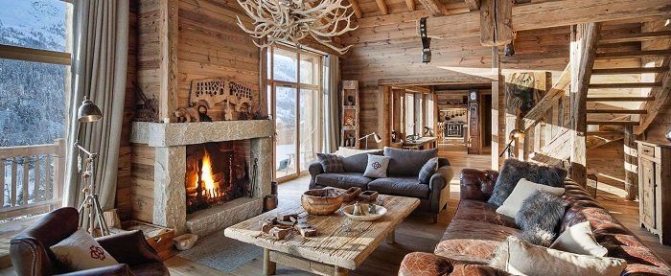

As already mentioned, internal thermal insulation allows you to leave the facade of the building unchanged. Nevertheless, it is recommended to resort to insulation from the inside only if it is practically impossible to insulate the house from the outside.It should also be borne in mind that among all heaters, only jute and felt can be considered 100% environmentally friendly materials. Therefore, if possible, insulate the wooden house from the outside, and if this is not possible, pay close attention to the choice of materials for internal thermal insulation.
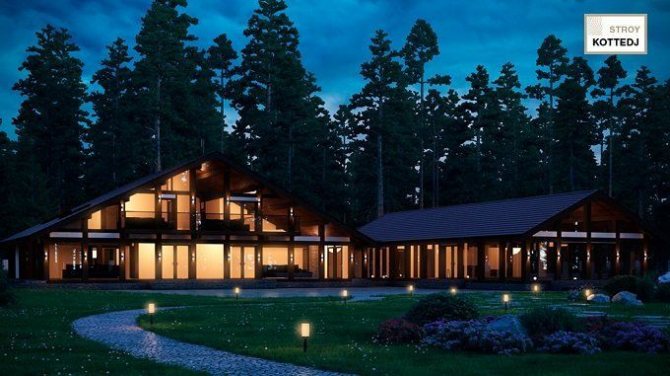

The process of insulation from the inside is labor-intensive and technologically complex in itself. In this regard, preliminary planning is necessary for all work that requires a lot of time and effort. To maintain the most healthy microclimate when insulating a building from the inside, only environmentally friendly materials should be selected.


Advantages and disadvantages of mineral wool
The spread of mineral wool is primarily due to its advantages:
- low thermal conductivity;
- incombustibility;
- mechanical stability - does not change its properties when exposed to it;
- sound insulating characteristics;
- resistance to thermal deformation;
- biochemical resistance;
- convenience and ease of mounting.
However, despite the impressive list of advantages, building codes do not recommend using ordinary mineral wool for insulating premises... This is due to the presence of phenol in its composition, which has a detrimental effect on human health. For internal insulation, the craftsmen are advised to use ecowool or stone wool.
If installed incorrectly, open areas of mineral wool come into contact with the ventilation system, as a result of which hazardous particles are released into the ambient air.
The choice of material for insulating the walls of a wooden house from the inside
Materials used for thermal insulation from the inside must:
- have low thermal conductivity to ensure its main function;
- comply with fire safety requirements for residential premises;
- ensure the design mechanical strength both separately and in combination with the building structure;
- be environmentally friendly and safe for living beings, do not emit harmful substances into the environment.
As a result, the method of internal insulation of a wooden house depends on the materials used. Today, the following types of materials are used:
- Basalt mineral wool
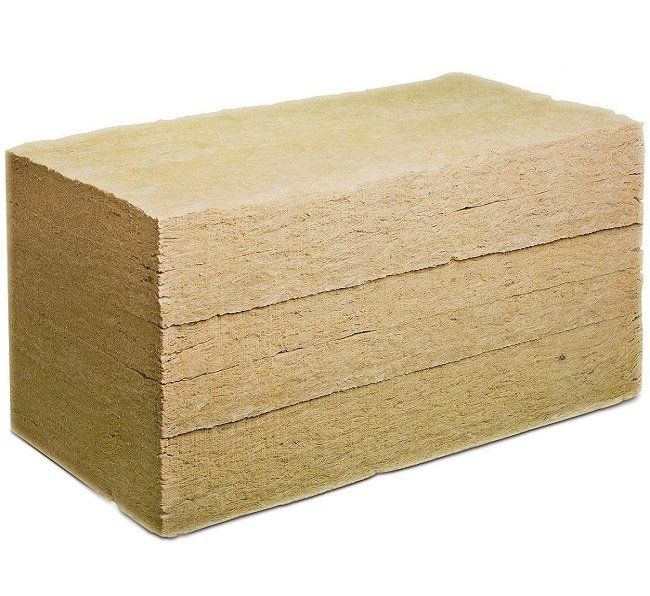

Thermal insulation of walls from the inside in a wooden house with mineral wool slabs is the most common method. This material is non-combustible and environmentally friendly, it has excellent thermal insulation and sound insulation. However, mineral wool is hygroscopic and has low strength. This obliges, firstly, to cover it with a layer of vapor barrier material, and secondly, to additionally protect it with a fencing structure.
- Expanded polystyrene
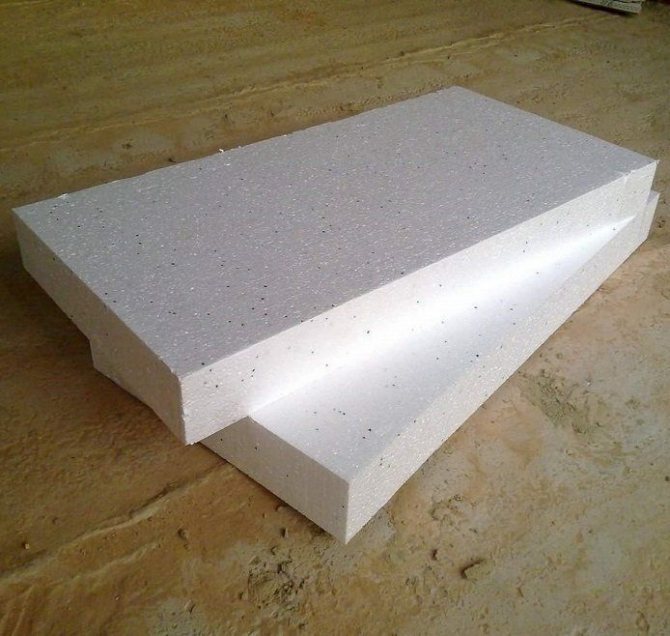

The material is used in the form of plates of various modifications: penoplex and polystyrene. Expanded polystyrene does not allow water vapor to pass through, therefore it does not require a vapor barrier, but waterproofing is necessary for it. In comparison with basalt mineral wool, expanded polystyrene is about 1.5 times more efficient in retaining heat.
Thermal insulation of the walls of a wooden house with foam is actively used by homeowners for thermal insulation from the inside. However, styrene foam can release hazardous substances containing styrene, so this material is not recommended. Much more dangerous compounds (hydrogen cyanide, toluene diisocyanate) are released by non-pressed polystyrene foam during combustion. Therefore, it is allowed to use only an extruded type of expanded polystyrene with a flammability class G1. This material also requires an enclosing structure.
It is better to insulate the walls of a wooden house from the inside with penoplex. Fine-celled polystyrene is more durable and retains heat better than polystyrene foam.
- Glass wool
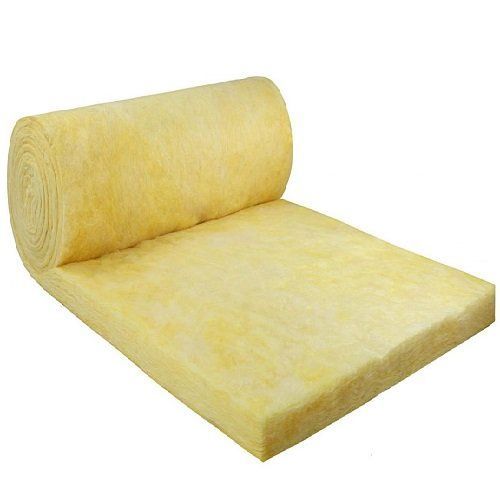

Glass wool is widely used when performing insulation work.This material is cheaper than basalt mineral wool, while it has a higher thermal conductivity. For insulation from the inside, only a special type of glass wool should be used, which must be covered with a film. Due to the small particles that are hazardous to health, released by glass wool, during installation, you must protect yourself with protective equipment for the skin and respiratory organs. Glass wool insulation should include enclosing elements.
- Penofol
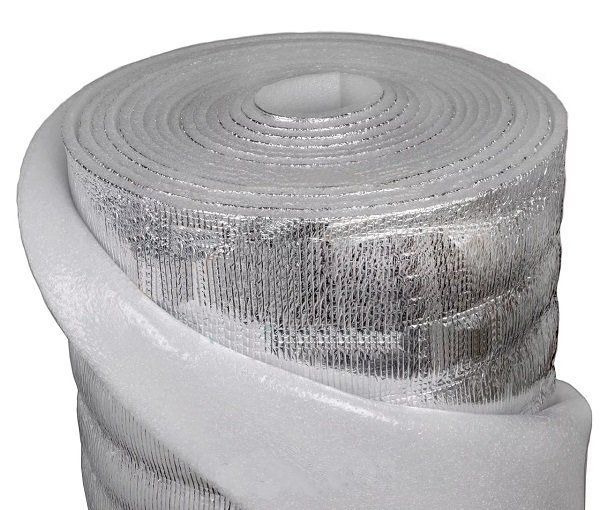

Insulation of the walls of a wooden house from the inside with penofol is a modern type of building insulation. Including it is used in internal work. The material is produced in the form of foamed polyethylene rolls covered with foil on one side. Polyethylene provides thermal insulation, and the foil layer reflects the heat inside the room. Thanks to the foil layer, the strength of the material and its moisture resistance increase, while the flammability of the material also increases, therefore penofol is classified as class G1.
- Izoplat
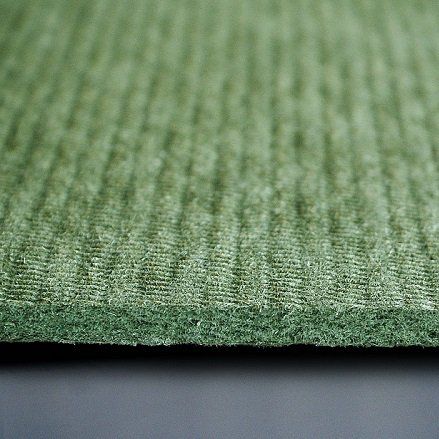

Isoplat is a modern material consisting of a layer of pressed flax fiber and fiberboard with a thickness of 12-25 mm. It has high strength, which eliminates the need to build enclosing structures. The insulation is environmentally friendly, it can be used to insulate the walls of wooden houses from the inside. However, the thermal conductivity of izoplat is relatively low, and the price is relatively high, in contrast to other types of insulation.
- Polyurethane foam
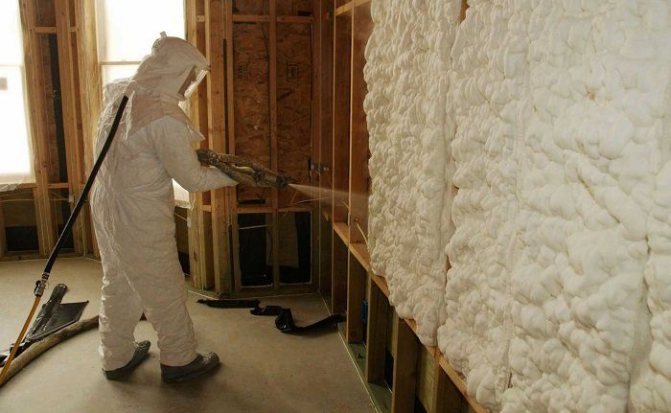

The modern method of thermal insulation using polyurethane foam is carried out by spraying it from the inside onto the surface. For the production of work, appropriate equipment is required; enclosing structures are not required
- Ecowool
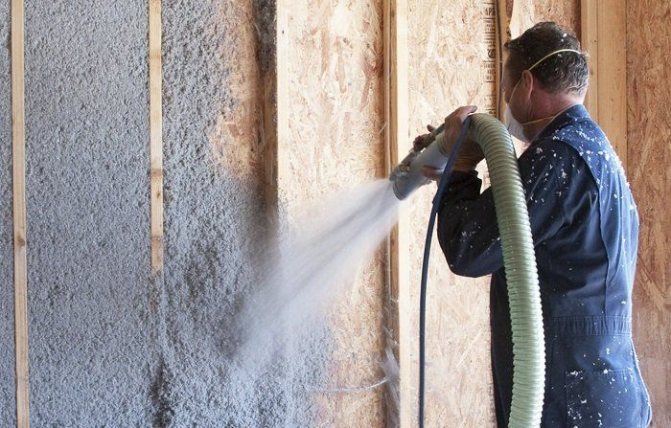

This fairly new material is currently gaining popularity. Among its advantages it is worth noting:
- environmental friendliness (natural wood fibers are the basis);
- vapor permeability;
- fire safety and resistance to biological factors due to the content of special additives;
- low thermal conductivity;
- low price.
With the help of ecowool, horizontal surfaces are also insulated. However, only the ceiling and floor can be insulated on their own, since appropriate equipment is needed to insulate the walls from the inside.
- Warm seam
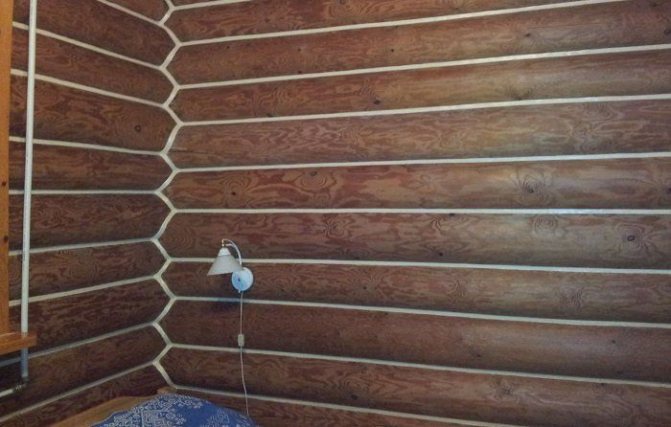

This technology of insulating the walls of a wooden house from the inside implies sealing joints and seams. It is used when it is necessary to leave a wooden wall without finishing and decoration. In this case, only the joints between logs or beams are insulated with the material, thus reducing the thermal conductivity of the joints and seams.
The insulation material is synthetic sealants based on acrylic, silicone, latex and bitumen, as well as more traditional natural sealants - tow, linen wool and linen rope.
Advantages of the "warm seam" technology:
- simple technology that allows you to independently carry out insulation;
- cost-effective technology;
- improving the thermal insulation properties of a wooden wall without disturbing its original appearance;
- high vapor permeability of the material, due to which a favorable atmosphere is created in the room and the durability of the protective structure increases.


Internal ceiling insulation
Home insulation should be started from the ceiling, because warm air always rises upward and if there is no insulation, part of it comes out through the roof. If the house is one-story with an attic, work begins with spreading waterproofing material on the ceiling from the attic. Mineral wool or sawdust can be used as insulation, which should be distributed around the entire perimeter of the waterproofing. The thickness of the insulation can be 150-250 mm. Planks are spread on top so that you can move freely around the attic.
Important: If the house is with an attic, then insulation is carried out, in addition to the interfloor overlap, and the roof slope. For wooden floors, loose materials are poured between the logs, and for concrete, slabs or roll material are laid.
The slope is insulated first with a waterproofing film, on top of which a heater is placed, and on top of an impermeable membrane. Everything ends with a crate.
The note: For ceiling insulation, mineral wool can be used, and parchment as a waterproofing layer.
In order to insulate the ceiling from the inside, a wooden frame is first made, in which the distance between the boards should be up to one meter. Parchment is glued between the boards with tile glue. Insulating material is placed on top of it, to fix which you can also use a small amount of glue. Further, the ceiling is sheathed with plasterboard. It is screwed onto a wooden frame with a screwdriver.
Important: Ceiling insulation should be carried out after construction no earlier than a year later and only during a warm period.
The procedure for insulating the walls of a wooden house from the inside
Before carrying out work, the walls must be prepared. This is especially true for the insulation from the inside of an old wooden building, when the old insulation has managed to cackle during operation. The work at this stage is to eliminate the formed cracks through which cold air enters. The surfaces of the base are preliminarily cleaned of dust and dirt accumulated on the walls.
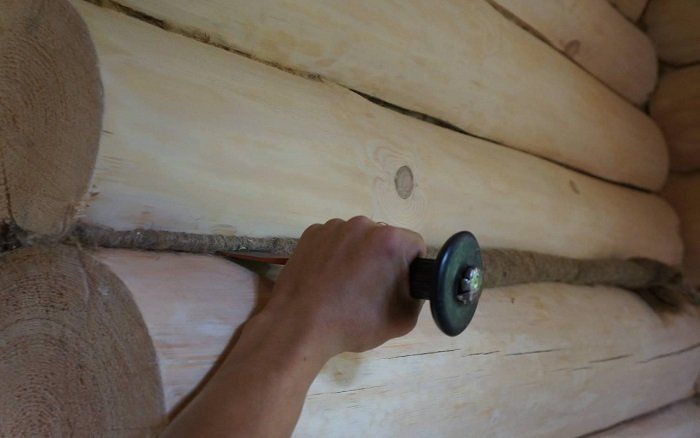

The wooden blockhouse gradually shrinks, as a result of which cracks can form in the walls. Immediately before insulation from the inside, old walls must be dug up. Jute is usually used for caulking, and if the gaps are wide enough, it is better to use tape tow. Caulking is carried out by hammering the material with a chisel in the gap between the logs or beams. Thus, protection of the log house from blowing is provided and additional thermal insulation is created. It is necessary to hammer the material in the slots until the slots are completely filled with it, until it protrudes outward. The quality of insulation of the walls of a wooden house from the inside also depends on high-quality caulking.
Internal insulation is carried out in several stages:
- Antiseptic wall treatment
- Wall waterproofing
- Installation of the frame and thermal insulation
- Vapor barrier
- Exterior wall decoration
First, the strength of the wood is checked, which should not be affected by insects, bacteria and fungus. To prevent future contamination of the tree, it is treated with antiseptics. Additionally, the surfaces of the walls are treated with fire retardants that resist the fire of the tree.
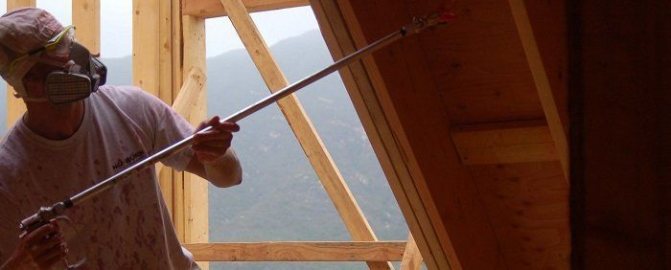

The insulation should be protected from moisture, for which its outer surface is covered with a layer of wind and waterproofing material. As a result, protection against weathering and the ingress of atmospheric water is provided.
Several materials are used for protection, the best of which is a vapor diffusion membrane. It protects against moisture, but at the same time allows air and steam to pass through, allowing the wooden walls to breathe and helping the insulation to get rid of accumulated moisture. Membrane sheets are attached to the wall with a construction stapler, overlapping each other by at least 10 cm. The joints are then glued with tape or construction tape.
The basis of the insulation is a specially designed frame. Bars with a section of 40x50 or 50x50 mm are suitable for its construction. This section is sufficient to provide the required structural rigidity. The vertical racks of the frame are attached to the floor and ceiling from the inside with profiled plates and self-tapping screws.
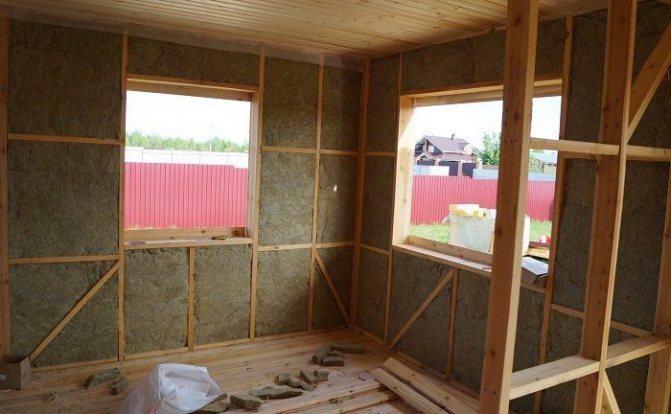

To ensure greater rigidity and strength of the structure, it is attached to the walls with large self-tapping screws.To facilitate the installation of insulation, the pitch of the frame racks should be selected in accordance with the dimensions of the insulation sheets - 600 or 800 mm.
If the pitch of the vertical racks is observed, the sheets of insulation do not need to be fixed. They are installed close to the elements of the frame and are held at the edge. At this stage, it is important to fill the entire space between the vertical posts with insulation, otherwise microconvection may occur through the cracks with the formation of cold bridges through the cracks in the insulation.
Vapor barrier is required in the case of using mineral basalt wool, glass wool or expanded polystyrene as an insulation material. The installation of the vapor barrier film is carried out by fixing it with a construction stapler to the ventilation crate. It is required to provide sufficient tension on the film so that a ventilation gap forms between it and the wall surface. The sheets of film are overlapped with each other by at least 10 cm and then fixed with tape and a construction stapler.
If the material for insulation is extruded polystyrene foam, it is not necessary to carry out vapor barrier. This material itself provides reliable protection against moisture.
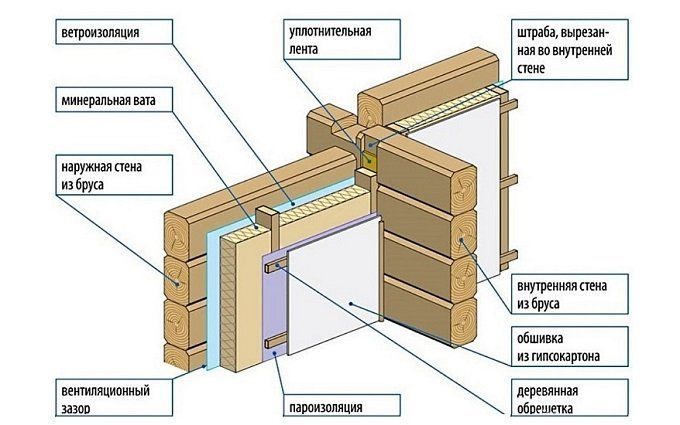

The metal frame can be the basis not only for insulation, but also for finishing elements. To preserve the wooden interior, you can sheathe the walls with clapboard. If wallpapering is planned, the insulation is closed with sheets of drywall.
After the completion of the building's thermal insulation from the inside, the air humidity in the premises will increase. Therefore, it will be necessary to install forced ventilation in the house. Using an outdoor hood will result in heat loss, so it is better to use a medium power axial fan. By ventilating the room for 20 minutes, it is possible to get rid of the accumulation of condensation in the room.
When insulating a wooden house on your own, you should not neglect waterproofing in order to avoid problems with the insulation getting wet. When choosing a material for insulation, study its characteristics and do not try to save money at the expense of quality. Follow the advice of the professionals.
Preparation for work
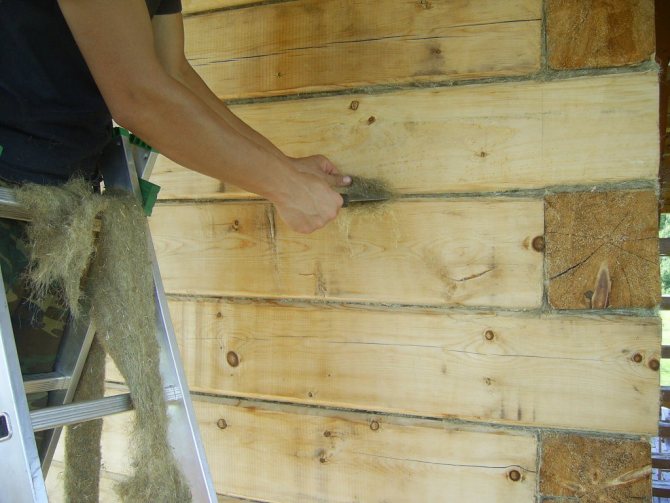

Before insulating a wooden house from the inside, it is necessary to carry out preliminary engineering work.
Whether internal insulation in the house is possible, and also how effective it will be, will be shown by the heat engineering calculation. Next, you need to determine the position of the dew point - the place where most of the condensate is likely to collect. This is very important as it influences the choice of material.
If calculations show that the dew point is on the inner walls, and especially where the insulation is planned to be located, then this is not a very good indicator. The house, of course, will be warm, since the insulation will perform its functions in any case. But in the cold season, dampness will accumulate in the room, which will not only spoil the insulation itself, but also provoke rotting of the walls and the cultivation of mold.
Ideal if the dew point is outside. In this case, you can freely insulate a wooden house from the inside.
Also, do not forget that any wooden house shrinks over time. When the heating is turned on, the wood dries out a lot. All this affects the size and shape of the log or bar.
Even in a well-built house, the gaps at the joints of logs or beams can increase, allowing a significant amount of heat to pass into the street. Therefore, before installing the insulation, it is important to seal up all the joints. This can be done both with tow or jute, and with special sealants.
Another important preparatory stage before insulation is the fire-retardant protection of the tree.
The protective composition will permanently protect the tree, sheltered from the eyes with insulation, from fire and the appearance of harmful insects.You should not skimp on fire-retardant composition, you must choose the best one.
The structures on which the insulation will be attached should also be treated with the composition, if they are wooden.
Important nuances of the technology of insulating the walls of a wooden house from the inside
When working with insulation, a heat engineering calculation must be performed. In the process of work, it is important to correctly determine the border of the dew point, which should not pass through the thickness of the inner walls and insulation. Thus, the effectiveness of the chosen method of insulation and the method of its installation is proved.
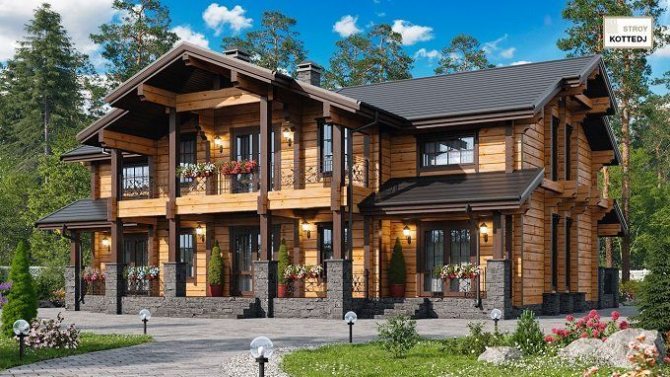

An incorrect dew point determination will lead to high humidity in the dwelling during the autumn-winter period. Despite the fact that the house will remain warm, due to high humidity, mold and fungus will appear, the tree will begin to rot, and the insulation will eventually become unusable. In addition, dampness and mold are fraught with the development of lung diseases in residents.
To insulate the walls of a wooden house from the inside, you should select suitable materials that do not violate the requirements for internal thermal insulation:
- minimum thermal conductivity;
- heat resistance or minimal flammability with the ability to self-extinguish upon ignition;
- high compressive and bending strength;
- ecological cleanliness;
- chemical and biological safety.
Wall insulation must be carried out over the entire area, even if a relatively small part of it freezes. If heating elements impede access to the wall, it is advisable to use foil plastic, the characteristics of which allow high-quality insulation of the wall. When installed, a sheet of foil plastic is placed with a foil layer towards the room. The aluminum foil will thus serve as a heat reflecting shield.
Greater insulation can be achieved by leaving a gap between the surfaces of the wall and the insulation. The effectiveness of the insulation will increase, and the air gap will help remove excess moisture. However, do not make the gap too wide.
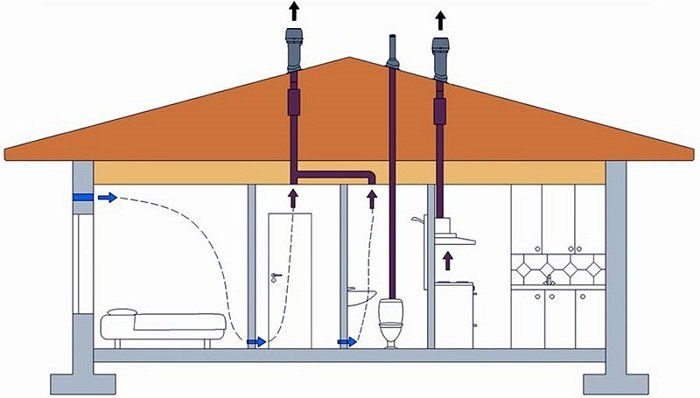

When insulating walls, you need to think about the ventilation of the premises. The ventilation system will relieve the wooden house of excess moisture that appears after the walls are insulated from the inside. To ensure a favorable microclimate in the premises, forced ventilation is required. It can be created using an axial fan of low or medium power.
The type of insulation is selected depending on the characteristics of the building. With the choice of a suitable option, qualified specialists can help, who for a certain amount will also perform all the necessary work on the thermal insulation of the building. But there is an opportunity to save money and do all the work on your own, subject to the choice of high-quality material and competent performance of the work.
Before starting work, you need to find out the following points:
- The kind of wood from which the house was built.
Each type of wood has its own properties and characteristics, which will affect the overall budget for insulation work.
- Reasons for heat loss.
You should carefully examine the wooden walls for cracks and cracks, and the existing insulation for defects.
When the shortcomings are identified and the scope of work is formed, you can proceed directly to the wall insulation.
If a new wooden house is being insulated, it is not necessary to dismantle the wiring in it. The electrical wiring is laid after the thermal insulation works and the installation of the inner lining have been completed.
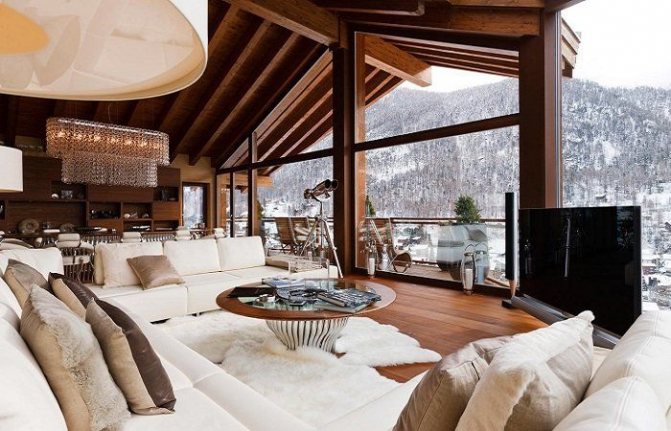

In a building in use, the existing external wiring must be removed. Moreover, both open wiring and communications hidden in plastic casings are dismantled.
Rules for carrying out work on insulation
If the house is ready for thermal insulation, it's time to take care of the preparation directly for the installation itself. You will need the following tools and materials:
- insulation for sealing cracks in the walls: tow, jute, sealant;
- for laying natural sealants - a set of chisels, for synthetic - a spatula;
- fire retardant composition for wood processing;
- roller, wide brush or spray gun for applying fire protection;
- hydro and vapor barrier films;
- foil tape;
- construction stapler;
- wooden bars and slats for the installation of the battens;
- self-tapping screws;
- insulation, calculated based on the area of \ u200b \ u200bthe walls with a small margin;
- a tool for cutting material;
- level and plumb line, tape measure, screwdriver, screwdriver, hammer.
Features of the choice of insulation
Before insulating a house from a bar from the inside, you need to choose a suitable insulating material.
The characteristics that the insulation should have:
- low thermal conductivity;
- low weight;
- vapor permeability;
- shrinkage;
- incombustibility;
- environmental friendliness;
- cheapness.
Mineral wool materials
Insulation of the walls of a log house is most often done with mineral insulation.
Advantages:
- light weight;
- fire safety;
- high vapor permeability;
- environmental friendliness;
- pest resistance;
- the presence of a foil layer (allows you to exclude the installation of a vapor barrier);
- affordable price.
Thermal insulation with basalt wool inside the house from a bar
Features of insulators with different base:
- Basalt wool is a non-shrinking material in the form of slabs (ISOLIGHT, ISOLIGHT-L ROCKWALL, PAROC, Nobasil), non-hygroscopic, withstands temperatures up to 1000 ° C.
- Fiberglass plates, rolls (Izover, Knauf, URSA) have a high water absorption rate. The use of membranes, vapor barrier, waterproofing is required. Shrinkage of the material creates voids that affect thermal insulation.
- Ecowool - cellulose fibers (Isofloc, Termex, Ekovilla), slightly flammable, possessing antifungal, antibacterial properties due to the presence of boric acid in the composition. When water is added to a container with cotton wool, a composition is formed, which is best applied to vertical surfaces with special equipment. Such adhesives make it possible to insulate geometrically complex structures.
Expanded polystyrene and penoplex
The materials are chemically similar to foam. They are made from polystyrene granules. Penoplex has a more finely porous structure that is resistant to mechanical stress. Expanded polystyrene in structure is closer to polystyrene.
Advantages:
- Moisture resistant insulation - does not require additional waterproofing.
- Non-toxic - there is no release of formaldehyde resins during operation.
- Low weight makes assembly work easier.
- Resistance to fungi and mold. Does not rot.
Disadvantages:
- High flammability. Flame retardant treatment does not improve material properties.
- Low vapor permeability.
- It degrades when interacting with dichloroethane, benzene. When gluing to an insulated surface, the adhesive must be selected without solvents.
- The material is additionally processed with chemical compounds to exclude the formation of mouse nests, insect colonization.
Thermal insulation of internal walls with foam plastic
Insulation of a log house from the inside requires the use of vapor-permeable materials, therefore, the use of expanded polystyrene and expanded polystyrene is undesirable
... The resulting condensation between the insulator and the wood will lead to rotting of the wooden frame, mold will form, and fungus will appear.
Penoizol
Urea foam is produced in three forms:
- Liquid - resin, phosphoric acid and foaming agent, after mixing, are supplied under pressure to the insulated surface using a special device. After solidification, a material similar to polystyrene foam is formed.
- In sheets - liquid material is poured into molds. Further it is used as a slab insulation.
- In the form of granules - obtained from rejected sheets. It is used for insulation of floors, floors.
Penoizol advantages:
- Low thermal conductivity.
- Seamless filling eliminates cold bridges.
- Non-flammability.
- Moisture resistance.
- High performance of noise absorption.
- Adhesion to all types of surfaces.
- Possibility of filling voids in walls and ceilings without dismantling the structure.
- After curing, it is non-toxic.
- Saving time when performing work.
- Resists microorganisms.
Minuses:
- Low vapor permeability.
- The liquid insulator is applied with special equipment.
- Work with the material takes place at a temperature of + 5 ° C and above.
- Release of harmful substances in the process of spraying onto the surface and during the hardening period.
Insulation with penoizol inside a log house
Some good tips
- In order to avoid mistakes, you must strictly follow the instructions;
- For high-quality installation of the material, the plate must have a width of more than one meter;
- In order for mineral wool for wall insulation to last longer, it is necessary to create a high-quality vapor barrier;
- The material should lie firmly and evenly on the surface. When filling the grate with insulation, it is important not to allow gaps;
- Insulating walls with mineral wool slabs is much easier than using mineral water in rolls;
- The wall on which the insulation is applied should not have cracks and defects.
Well, I would like to hope that this article will help the reader to understand and understand what mineral wool is, what properties it has, how to use it correctly in order to preserve heat in the house. Let the wall insulation with mineral wool for everyone seem to be an easy job with a positive result!
Floor insulation
If walls and ceilings are insulated, then floor insulation is mandatory. But first, you need to dismantle the old wooden floor. After dismantling, the base is cleaned from dirt and other debris. This work has its own subtleties: firstly, the choice of material for insulation (floor insulation in a wooden house) and the method of installing a new floor, and secondly, at the request of the client, the installation of a "warm floor" is to be done.


"URSA XPS", "Technoplex", "Primaplex" - these heaters for the floor of a wooden house in all respects are suitable for arranging a new floor. Why? After cleaning and antifungal treatment, a special self-leveling mixture of 2 cm is poured onto the base of the floor, after it has dried, expanded polystyrene sheets of the selected brand are glued directly onto it. After installation, pour in another 3 cm portion of the self-leveling mixture. The result is a perfectly flat surface with a heat and sound insulation effect. The type of final flooring is chosen at the discretion of the client - wood planks, parquet or linoleum.
Another option for floor insulation is filling the space between the old boards and the base with expanded clay or slag, as well as loose foam. The layer of bulk material should be up to 25cm. The gaps between the boards are sealed with a special putty.
Which basalt wool is better to choose
The effectiveness of wall insulation with basalt depends on the correctly selected insulation and compliance with the insulation technology. Among the criteria by which it is necessary to choose a heater: the thickness and density of the mats, as well as the manufacturer.
Thickness. The thickness of stone wool for wall insulation depends on the climatic zone in which the house is built (the apartment is located) and on the type of walls: concrete, brick, wooden or frame.
For central Russia, a 50 mm thick basalt insulation layer inside the building perfectly copes with its function. For the facade, a thickness of 100 mm is needed, for a frame house - 150-200 mm.
If you wish, you can use the online calculator to more accurately calculate the thickness of the insulation.
Density. The thermal conductivity of the material depends on the density index (the lowest for a heater with a density index of 60-80 kg / m3) and the stiffness of the plates.The stiffness indicator is very important when insulating a frame house, where a lot of pressure is exerted on the bottom row and during finishing work directly on the insulation (decorative plaster).
The density of basalt wool for wall insulation should be within:
- 50-75 kg / m3 for frame houses;
- 80-130 kg / m3 for walls with a ventilation gap;
- 130-160 kg / m3 with a "wet" method of insulation;
- 150-175 kg / m3 for a concrete facade.
It is better to buy basalt fiber cotton wool from manufacturers that have proven themselves in the market. At the same time, it is not necessary to strive to purchase mats with the PAROC or Rockwool brand. They are of high quality, but the price is also very high.
For other manufacturers, the quality is fully consistent with European and Russian standards, and the cost is an order of magnitude lower. Therefore, why overpay for a trademark, if there are products, "TechnoNikol", "Isover", "URSA", as well as "Beltep" (Belarus).

